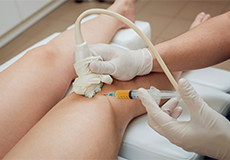Platelet-Rich Plasma (PRP) Injection

What is Platelet-Rich Plasma (PRP)?
Platelet-Rich Plasma (PRP) is a concentrated form of platelets and growth factors derived from your own blood to promote healing and tissue repair.
Blood consists of plasma, red and white blood cells, and platelets, which aid in clotting and healing. Platelets contain growth factors that help repair tissues, reduce inflammation, and stimulate new cell growth.
In normal blood, platelets make up about 6% of the total volume, but in PRP, they are concentrated to 94%, making it 5 to 10 times richer in healing properties.
PRP therapy is widely used in orthopedics and sports medicine due to its natural, regenerative benefits and low risk, as it comes from the patient’s own blood.
How is PRP Prepared and Administered?
The process involves drawing a small amount of your blood, which is then placed in a centrifuge to separate the platelets from other blood components. The resulting PRP is injected into the injured or affected area, often under ultrasound guidance to ensure precise placement.
Potential Benefits of PRP Therapy
PRP injections have been used to treat various conditions, including:
- Chronic tendon injuries
- Acute ligament and muscle injuries
- Arthritis-related pain
- Fracture healing
By utilizing your body's natural healing mechanisms, PRP therapy may reduce the need for more invasive treatments.
Considerations and Risks
While PRP therapy is generally considered safe due to the use of your own blood, it's important to be aware of potential risks, including: increased pain at the injection site, infection, damage to adjacent nerves or tissues, formation of scar tissue, calcification at the injection site. Discuss these risks with your healthcare provider to determine if PRP therapy is appropriate for your condition.
Post-Procedure Expectations
After the injection, you may experience some discomfort at the injection site for a few days. Your doctor may recommend pain medications and the use of cold compresses to alleviate symptoms. It's advisable to avoid anti-inflammatory medications, as they can interfere with the healing process initiated by PRP. You can usually resume normal activities but should avoid strenuous tasks until cleared by your healthcare provider.
Effectiveness and Repeat Treatments
The effectiveness of PRP therapy can vary based on factors such as the specific condition being treated and individual patient differences. Some patients may require multiple PRP injections to achieve optimal results. It's important to have a thorough discussion with your healthcare provider about the expected outcomes and the potential need for repeat treatments.
PRP therapy represents a promising option for those seeking a natural approach to healing. Make an appointment today to consult with one of our Sports Medicine Regenerative Specialist to determine if it's the right choice for your specific condition.










